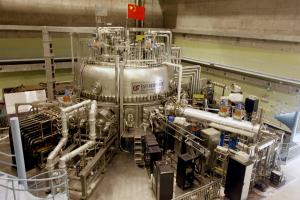EAST is ready to run after upgrade
The doors of the EAST superconducting tokamak in Hefei, China were closed on Monday 19 May, signalling the kickoff of the first round of the 2014 experimental campaign after nearly 20 months of upgrading activities.
Tremendous efforts have been made during past two years to enhance the capabilities of EAST, including the upgrading or modification of nearly every sub-system except superconducting magnets to enable higher performance and truly steady-state operation.
In the upcoming experimental campaign, the EAST operator ASIPP (Institute of Plasma Physics, Chinese Academy of Sciences) hopes that the tokamak can realize high performance steady-state operation of over 400s plasma duration, which is also one of ITER's targets.
The major upgrades on the machine include: an increase of the heating and current drive system capacity from 10 MW to 26 MW (see detail below); the installation of 76 diagnostic systems to collect information on all plasma parameters; the replacement of the upper divertor with an ITER-like tungsten monoblock configuration that has a heat-removing capacity of up to 10MW/m²; the installation of top and bottom internal cryopumps with a 160M³/s pumping speed; the introduction of 16 ITER-like resonant magnetic perturbation coils together with several other new edge-localized mode (ELM) mitigation methods; the installation of two ITER-like vertical stability coils to better control plasma vertical displacements; an upgrading of the fast control power supply and plasma control system to facilitate the control of high plasma performance discharges; and, finally, the improvement of systems such as the poloidal and toroidal field power suppliers, cryogenics, cryogenic transmission lines, high-temperature superconducting current leads and fuelling systems for more reliable operation.
Pump-down operations are beginning at EAST. Plasma operation can be expected at the end of June after a successful cooldown and the full commissioning of all upgraded sub-systems. The major task of the first campaign, which will be completed at the end of July, is to tune each and every sub-system so that they perform with high reliability and availability and to establish a solid technical base for the next campaign. Over 100s in H-mode operation is foreseen in this campaign.
The second campaign of the year is planned to start in October when additional neutral beam and electron cyclotron heating power is added (see detail below).
As always, EAST is open to the worldwide fusion community. Calls for experiment proposals will be sent out in early September with a list of detailed machine capabilities and diagnostics. We look forward to working with our international partners to achieve exciting results on EAST.
* The capacity of EAST's heating and current drive systems has been increased from 10 to 26MW as follows: 4 MW CW 2.45GHz and 6MW 4.6GHz LHCD systems; a 12MW CW ion cyclotron radio frequency heating system with wide band frequency of 26-70MHz; and a 4MW 50-80keV neutral beam injection system. In October, a second 4MW neutral beam injector and a 2MW electron cyclotron resonance heating system of 140GHz are expected.


